For Appointment Call 040 - 2712 4747
Procedures
Prosthodontics
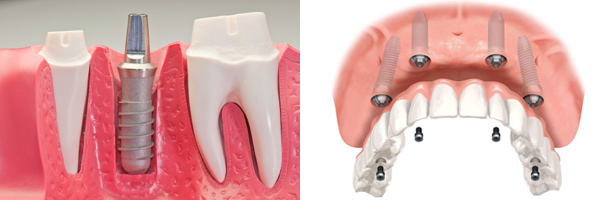 |
|
Missing tooth solutions: Dental Implants |
|
 |
|
| Dental Implants are the latest innovation to replace a missing tooth or a number of teeth. An implant consists of an artificial titanium rod which is placed directly into the jaw bone and acts as a replacement for the root portion of the natural tooth. The implant is made using pure titanium which allows new bone cells to grow around it: the implant then integrates with the newly formed bone which firmly locks it into place. This process is called ‘Osseointegration’. | |
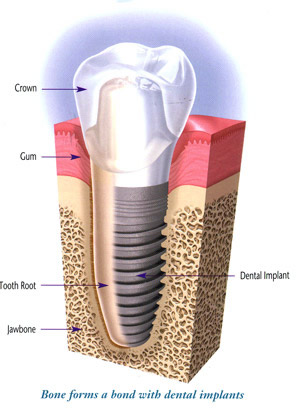 |
|
One tooth – One implant will be placed, a crown will then be fixed on top of the implant. |
|
Several teeth - Either several implants and crowns will be placed or a dental bridge will be fitted onto the implants. |
|
All the teeth - A number of implants are placed, then either a fixed bridge will be fitted onto the implants or the implants will be used to firmly hold a removable denture. |
|
Dental Implants Information |
|
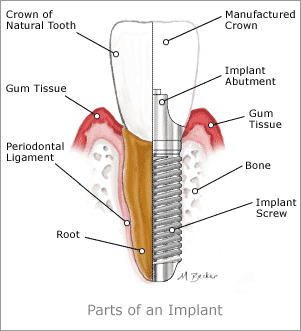 |
|
Initial Consultation |
|
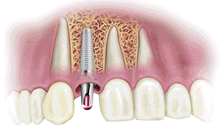 |
|
| A consultation appointment is necessary see if you are a suitable candidate for dental implants and to explain the process of placing an implant. X-rays may be taken and impressions (moulds) of your teeth. A treatment plan will then be drawn up detailing all the appointments required and the costing. How are implants placed? You will be given a local anaesthetic to numb the area around where the Implant is being placed. For patients who are anxious sedation can be given. An incision is made in the gum where the implant is going to be placed, to expose the bone; a small hole is then drilled into the jaw bone. |
|
The titanium implant screw is inserted into the bone. A protective cover or ‘healing cap’ is placed over the top of the screw. This is either left visible in the mouth, or if the implant is deep in the jaw bone the gum will be stitched over the healing cap.This is left for 3 to 6 months to allow new bone to integrate with the implant allowing osseointegration to happen. If osseointegration does not occur the implant will fail.When the implant has securely integrated with the jaw bone the healing cap is removed. The final crown or bridge can be cemented or screwed into place or a removable overdenture can be clipped onto or supported by the implantsOn occasion it may be necessary to place a temporary crown or bridge for a few months to allow the gum to heal fully before the permanent restoration can be fitted. |
|
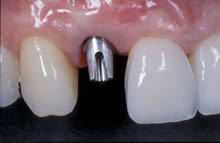 |
|
| Looking after your Implant Good oral hygiene and regular check-ups with the dentist and hygienist are a very important part of looking after your implants as the gums need to remain healthy. The implants can then last a lifetime. B) Crowns |
|
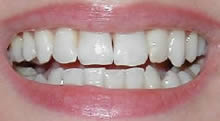 |
|
| A crown is a tooth shaped cover which fits over the existing structure of your natural tooth to protect and restore the tooth’s function. | |
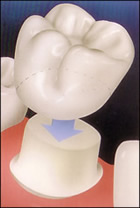 |
|
| Crowns can be used to - | |
Strengthen teeth which have been weakened by decay or a large filling. |
|
Protect fractured, cracked and worn teeth. |
|
Improve the shape, alignment and shade of a tooth. |
|
After root canal treatment, to help strengthen the tooth. |
|
| Each crown is individually handcrafted by our dental technician to create a healthy, natural look. | |
 |
|
| Crowns can be made using the following materials – all metal (often gold)or tooth coloured crowns such as porcelain fused to metal (often gold or a gold alloy), full ceramic (porcelain) or composite (plastic with glass particles embedded). The material used will depend on why you are having the crown. | |
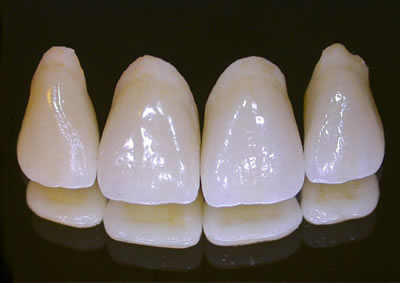 |
|
| Whether you choose to have a crown to improve the shape and alignment of your teeth or to strengthen your tooth, the procedure is the same. | |
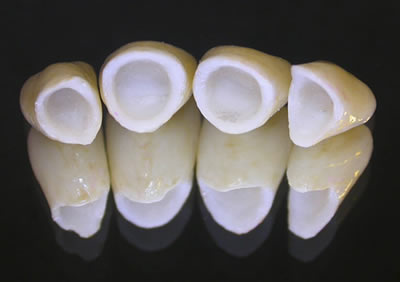 |
|
| Two appointments are necessary, the first to prepare the tooth for the crown and the second to fit the crown. | |
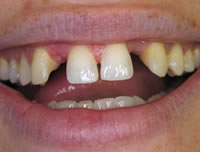 |
|
The preparation appointment |
|
 |
|
pre-treament |
|
 |
|
during treatment |
|
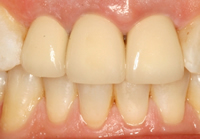 |
|
completion |
|
A local anaesthetic may be need to numb the tooth and surrounding gum |
|
The dentist will then shape the outer surfaces of the tooth, creating a cylindrical shape onto which the crown will seat. |
|
| An impression (mould) is taken of your teeth using special dental "putty"generally made from silicone. The putty is placed into an impression tray; they are both then inserted into your mouth and pushed over your teeth in order to take an impression. Once the dental putty is set, the impression will be removed. An impression is also taken of the opposing teeth, so the technician can see how you bite together | |
A temporary crown will be cemented onto the prepared tooth to protect it whilst your crown is being fabricated. |
|
The impression will be sent to the Dental Laboratory where our technician will handcraft your crown. This will take between two and three weeks. |
|
Bridge |
|
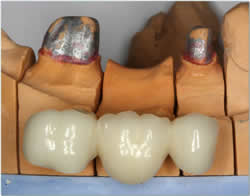 |
|
| A bridge is one of the options to replace one or more missing teeth. It is a permanent fixture which is anchored to the adjacent natural tooth or teeth (the abutment) to ‘bridge’ the gap where the tooth (or teeth) is missing (the pontic). This also prevents the adjacent natural teeth from drifting. A bridge is a great option if you do not wish to have dental implants or a denture to replace your missing tooth or teeth. There are many different designs and materials which can be used for bridges: your dentist will discuss the best option for you. Each bridge is individually handcrafted by our dental technician to create a healthy, natural look which also sits comfortably with your bite. |
|
Preparation & Process: |
|
| There are several types of bridges | |
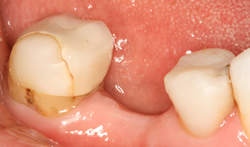 |
|
Zirconia Crowns |
|
Enhance Your Smile through Zirconia |
|
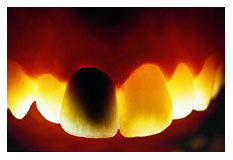 |
|
| Porcelain Fused to Metal (PFM) Crowns Zirconium Crowns | |
| The look of zirconium crowns and bridges is so close to natural teeth that it is hard to tell the difference and it is this quality which makes it very useable within dental work. Zirconium crowns can be fixed using traditional dental cements. Zirconium crowns have quickly become the preferred material for dental crowns. Zirconium is a very strong substance that can endure wear and tear of everyday use. When looking at Zirconium crowns from an aesthetic point it is clear and very similar to a natural tooth and reflects light the same way. This may be important if your new crowns are on the front of your mouth and it is particularly relevant in cases where the crown will be seen next to the natural teeth. Porcelain is the conventional material used for the new crowns however; Full porcelain can chip or break. This is overcome by making the crowns from the metal, in this case metal zirconia, then merge the porcelain on the outside. Zirconia metal gives the strength while the porcelain gives the appearance of a normal tooth. Zirconium crowns allow light to pass as a normal tooth would and that gives a natural look, unlike other metal cores that are block the light.Proved in worldwide research. Exclusively for our patients we have started using Zirconia in cosmetic treatment. Advantages of zirconia crowns over metal ceramics: |
|
|
|
Overview |
|
| These crowns do not corrode and the normal black gum line that you might see around a porcelain fused metal crown, will not occur, because of the strong ceramic material which is used. Also the hot and cold sensations you might feel with other crowns normally do not occur because of the lack of electrical conductivity. | |
Flexible Dentures: |
|
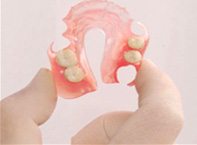 |
Flexible Dentures These are newer generation denture. They are light weight, flexible, does not contain any metal clasps, more aesthetic and patient friendly. |
Dentures: |
|
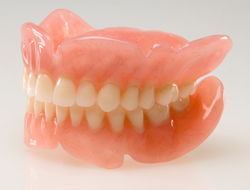 |
|
| There are two types of dentures – | |
Partial denture which replaces one tooth or several teeth. |
|
Full denture which replaces the whole set of teeth, on the upper or lower. |
|
| Dentures are kept in place by either using clasps which anchor around neighbouring teeth or by the dentures’ natural suction. On occasions a denture fixative or glue is recommended to aid in keeping the denture in place. All dentures are designed by the dentist or our dental technician to suit each patient’s individual needs. |
|
| Initial consultation Your dentist will assess your needs and thoroughly examine your mouth for suitability for dentures, looking at - |
|
All your existing teeth, checking for mobile teeth as these may have to be removed prior to having new dentures.Looking at existing restorations, fillings, crowns etc.The health of your gums, to make sure there is no infection present.The way the teeth bite togetherIf you have no natural teeth, accessing your gums and underlying bone. |
|
| The procedure will be explained to you and a treatment plan given stating all the stages and the costing. Generally, from 2 up to 4 appointments will be necessary as dentures are made in stages. The stages are the same whether you are having Full dentures or Partial dentures. The only exception being an ‘Immediate denture’, when a tooth is extracted and the denture is fitted immediately to replace the missing tooth. This denture will then have to be adjusted or replaced in 3 to 6 months after the extraction. The Procedure Appointment One – Impressions (moulds) will be taken of both your upper and lower teeth. These are then sent to the dental laboratory where the technician will fabricate a ‘special’ tray designed to fit your mouth perfectly and a wax bite block to record the way your teeth bite together. Appointment Two – Impressions (moulds) will again be taken, using the ‘special tray’ which the technician has made, this helps to achieve a more accurate mould of your teeth and gums. A registration of how your teeth bite together will be recorded using the wax bite block. Both the impression and wax block are sent to the laboratory where our technician will construct a trial denture. The shade of the teeth will also be taken at this stage. Appointment Three – The trial denture; The teeth are now set in wax, for Cobalt Chrome dentures the metal frame work is completed and the teeth are attached to the frame work with wax. You dentures will be tried in to ensure that it fits correctly, is comfortable and the teeth bite together correctly, any adjustments will be made at this stage. Your dentures are again returned to the Laboratory for the final stage of completion. Appointment Four - your dentures will be fitted. Your Dentures It will take a while getting used to new dentures, time and patience is needed. Upper dentures my affect your speech for a few days whilst your tongue gets used to having the denture in place, please persevere as this will soon pass. Dentures may cause soreness in the first 24 hours, if the soreness persists please contact your dentist as the dentures may need slight adjustments, this can be done at the surgery. Keeping your dentures clean at all times is important. Rinse them after meals if possible and brush them twice a day using toothpaste or soap and water. Dentures are only to be worn whilst you are awake; they need to be removed at night as your gums need to have ‘a rest’, having this rest keeps your gums healthy. Your dentures can then be sterilised in a denture solution while you sleep, always rinse or brush your dentures before putting them back in your mouth. If your dentures get stains that you cannot remove ask your dentist to clean the professionally at your next appointment. It is important that you still have regular examinations with your dentist even if you have no natural teeth, as the dentist needs to look for changes in your gums and the underlying bone. Also to check your tongue, throat, cheeks & lips for infection or signs of oral cancer. |
|